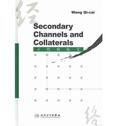二级经络学
2006-10-01
人民卫生出版社
Wang Qi-cai
647
Six years ago,I read a book entitled Research on the System of Channels andCollaterals and Its Clinical Application written by Prof.Wang.The theoryof channels and collaterals and its clinical applications was uniquelyand clearly presented.I was greatly impressed by its style and content.Since then,I made a point of seeking out Prof.Wang's books and articles,and although I had yet to meet him face to face,I felt I knew him wellthrough our academic exchanges over the years.Four years ago,I finallymet him in Qingdao,Shangdong Province at the Forum of Acupuncture Development in the New Century.
Professor Wang Qi-cai was born April 1948,in Nanzhang County,Hubei Province,China.After graduating with a TCM major from Hubei Collegeof Traditional Chinese Medicine,he stayed to teach acupuncture andto do clinical work and saentific research.In 1987,he transferred to theacupuncture department at Nanjing University of Traditional ChineseMedicine,where he became a chief instructor in clinical acupuncture.Currently,Professor Wang is supervisor of postgraduate students in theInternational Education College of Nanjing University of TCM.He isalso chief secretary of the clinical branch of the Chinese Acupuncture andMoxibustion Association and a consultant and visiting professor at theTCM Research Center in Hong Kong.Professor Wang is a lecturer in aSino-Japan special acupuncture research assoaation,a visiting professorat Liaoning International TCM Training Center,and a chief compiler forthe first edition of Acupuncture and Moxibustion,a basic textbook for TCMcolleges and universities.
Chapter 1 GenerallntroductionSection 1 The Origin and Formation of The Theory of Channels and CollateralsSection 2 Development of The Theory of Channels and CollateralsSection 3 The Classification of Channels and CollateralsChapter 2 The Eight Extraordinary VesselsSection 1 Clasification and SignificanceSection 2 DistributionsSection 3 CharacteristicsSection 4 Physiological functionsSection 5 Pathological ReactionsSection 6 Related PointsSection 7 ClinicalApplicationsSection 8 Case AnalysisChapter 3 The Twelve Divergent ChannelsSection 1 Nomenclature and DefinitionsSection 2 Courses and DistributionSection 3 Features of MarufestationSection 4 Physiological FunctionsSection 5 PathologicalReactionsSection 6 Related PointsSection 7 ClinicalApplicationsSection 8 Cases AnalysisChapter 4 CollateralsSection 1 Nomenclature and DefinitionSection 2 Courses and DistributionSection 3 Features of ManifestationSection 4 PhysiologicalFunctionsSection 5 Pathological ReactionsSection 6 Related PointsSection 7 ClinicalApplicationsSection 8 Cases AnalysisChapter 5 The Twelve SinewChannelsSection 1 Nomenclature and DefinitionsSection 2 Courses and DistributionSection 3 Features of ManifestationSection 4 PhysiologicalFunctionsSection 5 PathologicalReactionsSection 6 Related PointsSection 7 ClirucalApplicationsSection 8 Case analysisChapter 6 The Twelve Cutaneous RegionsChapter 7 Biao-branch and Ben-root,Gen-origin andJie-terminationChapter 8 Qi Streets and Four SeasIndex for PointsIndex for Diseases and Symptoms
The Chinese Acupuncture and Moxibustion Journal, 1990.6,reported 70 cases of renal colic pain after lithotripsy weretreated by puncturing Zusanli (ST 36) with strong stimulation,and manipulating needles during 5-10 minutes of retention.Results indicated the pain of 47 cases ceased after 15 minutes'stimulation, 19 cases had a reduction in pain, and 4 wereleft with no effect. The best result was that of pain releasedafter one minute's stimulation The slowest effect required 7minutes. According to the Zhe Jiang TCM Journal, 1983, 3, mastitiscould be treated by puncturing Zusanli (ST 36) with moderatestimulation and reducing method. During 30 minutes retention,needles were manipulated frequently, one treatment each day.For the acute condition in the initial stage, one treatment wasenough. For those with mastitis of longer duration of, 2-5 daysof treatments were required. The Acupuncture Clinical Journal, 1995,8, reported on32 cases of mastitis treated by puncturing Zusanli (ST 36),combining Taichong (LV 3) on the effected side with moderatestimulation and reducing method. Bleeding pricking waschosen for Taichong (LV 3)as well. There were 28 cases withoutsuppuration and 4 with suppuration. After 1-3 treatments,28 cases fully recovered. Two cases fully recovered after onetreatment 10 after two treatments, and 16 after three treatments.Four cases were left with no effect. Eighty cases of gout were treated by choosing Zusanli (ST 36) as the chief point, one treatment each day, 10-15 treatments to a course. Results were satisfactory. Some cases fully recoveredwith one course of treatment Lu Jingshan, Essential Selection of Diseases Treated with Single Point, People's Health Press, 1995,1. One studyreported of 20 cases of infantile incarceratedhernia treated by puncturing Zusanli (ST 36) and Tianshu (ST 25) with one minute of stimulation with lifting, thrusting, rotation, and no retention of needles. Five to ten minutes of clockwise massage on the incarcerated area with the palmer side of the fingers was added after withdrawal of needles. Results indicated that 17 fully recovered, 3 were left with no effect and required surgery Chinese Medical Journal, 1976,5. According to the Zhong Yuan Medical Journal, 1985,1, 600 cases of side effects from ligation were treated by injecting Zusanli (ST 36) bilaterally with 2ml of 1% procaine or Iml of 2% procaine with injecting liquid. All acFueved good results.10. Ashi Points Ashi point means regarding an area of tenderness as an acupoint. The features of Ashi points include no set location, no point names, and no relationship with the channels. The name of asru was first recorded in Essential Prescriptions Worth a Thousand Gold (Qian Jin Yao Fang), which related that when someone has pain, and the tenderness is pressed, the patient will involuntarily cry out, "ashi," or yes. When that location is punctured, an effect will be eliated, as with any other point. Ashi points have other names, such as "non-fixed points," as recorded in Jade Dragon Lyrics (Yu Long Ge), or Tian Ying point from Elementary Medicine (Yi Xue Ru Men), or, simply,"tenderness." ……
